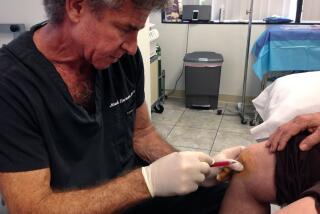Better oversight could cure doubts of stem cell project
It’s never pretty to see people get blown up by their own bombs. But it sure can be educational.
A case in point is the leadership of the California stem cell program, which pushed through Proposition 71 in 2004 to create the program, entrenched itself in almost unassailable control of its $3 billion in funding, and has self-righteously fought every attempt to improve public oversight over its disbursement of what is, after all, the people’s money.
That includes any attempt to amend the original language of Proposition 71, which they regard as Holy Writ.
Here’s the rub. They now assert that one provision written into Proposition 71 has become a big problem for them. This is the rule that limits the program to a maximum of 50 employees.
That’s not sufficient to manage a program that has already committed more than $1 billion to researchers, they say.
“Since 2006, we’ve gone from a portfolio of 16 grants to more than 320,” says the program’s vice president for operations, John Robson, who told me last week that the staff numbers 43 today.
“Our oversight responsibilities are increasing at the same time we’re trying to support new research,” he says. “We’re going to bump up against this 50-person cap.” He says it’s imperative to augment the program’s current complement of 21 science officers, who are MDs and PhDs qualified to ride herd on the program’s grant and loan recipients.
But raising the cap to accommodate the extra staffers requires approval by the state Legislature, which the stem cell program has always treated as an enemy. This is what Shakespeare described in Hamlet as being “hoist on [one’s] own petard.” (A petard was an explosive mine of the era.)
The good news for taxpayers is that the program’s request for more staff could open the door for our elected representatives to finally insist on some jurisdiction over the spending of our $3 billion -- $6 billion including interest on the state bonds with which the money is raised. The key questions are these: Is it being spent appropriately, and is it being spent without conflicts of interest? On both issues, there’s reason for doubt. Unfortunately, the program has managed to fend off every effort by elected officials to weigh in.
Here’s some background.
The stem cell program -- the California Institute for Regenerative Medicine, to use its formal designation -- was launched in response to President George W. Bush’s Luddite war on embryonic stem cell research. Proposition 71 was the creation of Robert Klein, a Palo Alto businessman whose son suffered from juvenile diabetes, a disease stem cell researchers were targeting.
Prop. 71, which Klein drafted, aimed to turn the state into a stem cell research mecca. But the initiative was also a model of legalistic micromanaging. It barred state legislators from making any change to the program for three years, and then only on a 70% vote of both houses. It specified that the program’s board would have 29 members and dictated how the seats were to be apportioned among interest groups. Klein ended up as its chairman.
The 50-employee limit was trumpeted by Proposition 71’s supporters as proof that the program would be lean and mean, with almost all the money going to science. You might think they must have known from the start that managing a $3-billion scientific research program would require a larger staff, but then that would make them look cynical, and who wants to do that?
Klein and CIRM have always responded with indignation to any legislative effort to exert oversight over the program. When then-state Sen. Sheila Kuehl proposed a bill in 2008 ensuring that Californians receive affordable access to treatments arising from CIRM-funded research, she was attacked by Americans for Cures Foundation, a lobbying group closely connected to Klein. The group boorishly smeared her as being “ignorant,” “mindless” or “playing dumb in a craven attempt to get Republican votes to back her legacy as defender of the poor.” Just so you know, while she served in the Senate, Kuehl was one of its outstanding progressive Democrats and a national leader on healthcare reform.
The lobbying group presently apologized, and Klein resigned as its president. But it still operates out of his office suite in Palo Alto.
Last year, when the Little Hoover Commission -- the state panel devoted to keeping state agencies accountable -- recommended changes in the way CIRM governs itself and in its relationship with elected state officials, CIRM blasted it with both barrels.
The commission observed that the unwieldy board contained no truly independent voices; Proposition 71 mandated that it be composed mostly of representatives of California institutions eligible for CIRM funding (UC campuses currently account for eight seats) and advocates for patients with conditions that may be treatable through stem cell therapies. The commission recommended cutting the board to 15 members and giving four seats to independent individuals, such as eminent citizens or scientists not eligible for its research handouts.
Two law firms associated with CIRM responded with a combined 24 pages of tendentious legal argument, to the effect that the proposals would “fly in the face of the voters’ intent.” CIRM hinted it might take the matter to court if the legislature tried to enact the commission’s recommendations without going to the voters.
It’s not surprising that CIRM isn’t enamored of outside scrutiny, as the little it gets hasn’t been wholly complimentary. At last week’s annual meeting of the Citizens Financial Oversight Accountability Committee, an auditing body established under Proposition 71 and chaired by state Controller John Chiang, CIRM officials came under withering questioning by committee member Loren Lipson, a physician and research scientist.
Lipson objected to CIRM’s practice of keeping the identities of grant applicants secret until and unless they win a grant. He thinks that without full transparency, it’s impossible to know whether the scientific peer reviewers or the board have shown undue favoritism to the victors.
That’s especially a problem, Lipson believes, because the stem cell research community is small and so much of the board is, by design, self-interested. “To me it looks like an old-boys club,” he told me after the meeting. “When I look at that board I get a bad feeling of impropriety.”
CIRM officials assured him that conflicts of interest aren’t a problem on the board or among its scientific peer review teams, but he remains unimpressed. “They never really answered my questions,” he says.
Chiang’s panel, meanwhile, passed a resolution at the meeting in favor of expanding its monitoring authority to look at performance issues, not merely financial matters. CIRM issued a statement the next day that said, essentially: Forget it -- Proposition 71 doesn’t allow that.
There’s no question that CIRM has funded important work and bolstered the state’s research profile. And there’s no reason to doubt that CIRM needs more staff scientists to make sure grant recipients are spending our money properly, especially since the program is about to start doling out loans to commercial companies, not just grants to academics.
But it’s ridiculous for CIRM to maintain that increased legislative oversight and a more compact and objective board are inimical to its purpose of fostering stem cell research in California. CIRM mouthpieces love to claim that the “voters’ intent” should be honored by keeping the program rigorously free of political oversight -- but then the voters’ intent was also to give it 50 staff members, and not a soul more.
Nothing requires the Legislature to crack open the door on Proposition 71 only as far as CIRM wishes. The Legislature should let the program have the additional staff, but on its own terms. These should include a change in CIRM’s board structure and imposition of the sort of oversight the program should have had in the first place -- including a reduction in the requirement for legislative amendments from 70% to a bare majority and giving Chiang the broader authority he requested. That’s the way to create a public stem cell research program that exemplifies not only good science, but good government.
Michael Hiltzik’s column appears Mondays and Thursdays. Reach him at [email protected], read previous columns at www.latimes.com/hiltzik, and follow @latimeshiltzik on Twitter.







